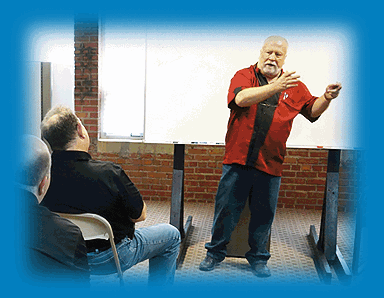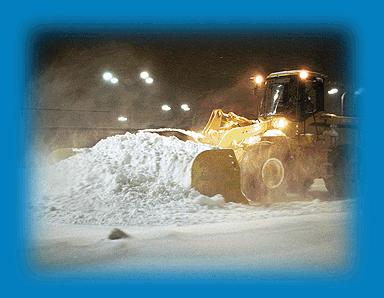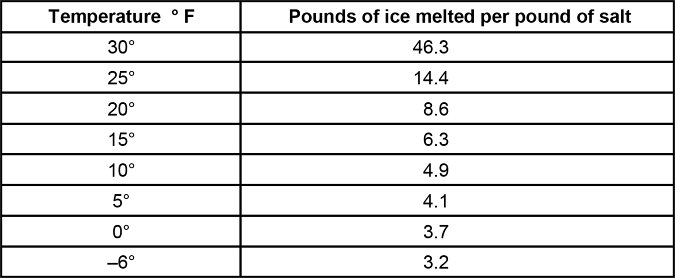









© 2023 Ice & Snow Technologies, Inc. Phone: (509) 525-3197





Snow and Deicing Expert
Snowplowing Project Consulting
Liability Expert for Snow and Ice Removal Companies
Patience Saves Money
by Dale Keep, Snow and Deicing Expert



One factor often overlooked when applying chemicals is the surface temperature and the time it takes deicers to
form a solution and melt ice at that temperature. It always takes time to melt the ice present, and the colder it is,
the more deicer product, and time it takes to get the job done. Ignoring this fact leads to repeat applications, over
application, higher overall costs, and a waste of chemicals.
Melting Capacity
All chemicals when applied as a solid melt ice by first forming a brine solution with water available from the ice
or snow present. This process takes time and depends on the pavement surface temperature, the amount of water
available and, to some extent, traffic action to assist in mixing the solution. Very simply, the colder it is the more
chemical it takes to get the job done.
The following table below shows how temperature affects the ability of salt to melt ice (melting capacity) in
terms of the weight of the water created.
This table shows that, as temperatures fall, salt (and all deicer chemicals) are less effective at melting ice or have a
smaller melting capacity. For example, more salt is needed at 20° F. than at 30° F. due to the reduction in melting
capacity (46.3 vs. 8.6). The capacity is reduced by a factor of 5.4 with all other conditions being equal. Or in other
words, if at 30° F. 1 pound of salt achieved the results desired; at 20° F. it would take 5.4 pounds. Note that all
deicers share this same trait, but not all deicers are equal in melting capacity. The data here applies to salt only.
Melting Rate
Melting Rate is a measurement of how fast melting occurs at different temperatures. Like melting capacity, it is
influenced by temperature. The following table shows a comparison of melting effectiveness and the effect of
temperature on the rate of melting only at two temperatures.
Application Rates
From the above information, it appears that a heavier application would increase the amount of ice melted in the
near term, however from an overall viewpoint the extra amount of chemical and cost is wasted because it is
ultimately not needed to melt the ice. Applicators too often expect nearly instant melting, and when the
pavement does not turn black in the rear-view mirror, the immediate thought and often action is to apply more
deicer chemical. This expectation of nearly instant results too often leads to over application and a waste of
resources. The lag time between application and complete melting is another reason for timely applications.
Earlier applications allow time for the chemical to act. Good pavement surface temperature information, weather
forecasts and an understanding of how deicers work provide the necessary information to determine the
application rate that best fits the current need.
Other Considerations
Retention
The lag time between application and melting can be a problem particularly when the chemical is applied at low
temperatures while attempting to melt and then dry pavements. Dry salt is susceptible to displacement by wind
and traffic action before it can begin to penetrate the ice. Pre-wetting with brine during application speeds up
the liquefying process, minimizes this problem and can not only be beneficial but often cost effective.
Training
Good training must present the correct information on how deicers work and how their application affects the ice
or snow surface under different conditions, including surface temperature. When used correctly, surface
temperature is key in determining the correct application rate and time expectations between the application and
the results. Training must address how to determine correct application rates based on the deicer being used,
current surface temperature and conditions, expected weather, time of day, and overall goals. Good training in
this area not only pays for itself quickly but consists of more than saying “Apply at 1/4 to 1/2 cup per square yard
and reapply as necessary”.
Customer and Level of Service
The customer should also be advised of how melting rates change as temperatures change and how at colder
temperatures application rates must go up to deliver their expected results. They should also understand that at
many times’ patience can eliminate the need for repeat applications. Open discussions with customers on deicer
use most often provides for better customer relations while preventing over applications, saving time, money,
and landscaping.
Summary
Truly understanding how deicer chemicals work and how surface temperature affects their melting capacities and
rates is very likely one of the most important things one can do to save money while still delivering quality
customer service. Understanding the process of melting ice in terms of the specific deicers melting capacity and
rate based on surface temperature is central to the intelligent use of chemicals. The task of the manager is to
know how to correctly determine the amount of chemical to use and when to apply it to best achieve established
goals. Success depends on understanding the relationship between pavement surface temperature and deicer
performance, while adding in details regarding recent weather conditions, expected weather conditions, time of
day and customer expectations to determine the correct amount of chemical to apply, and when best to apply it.